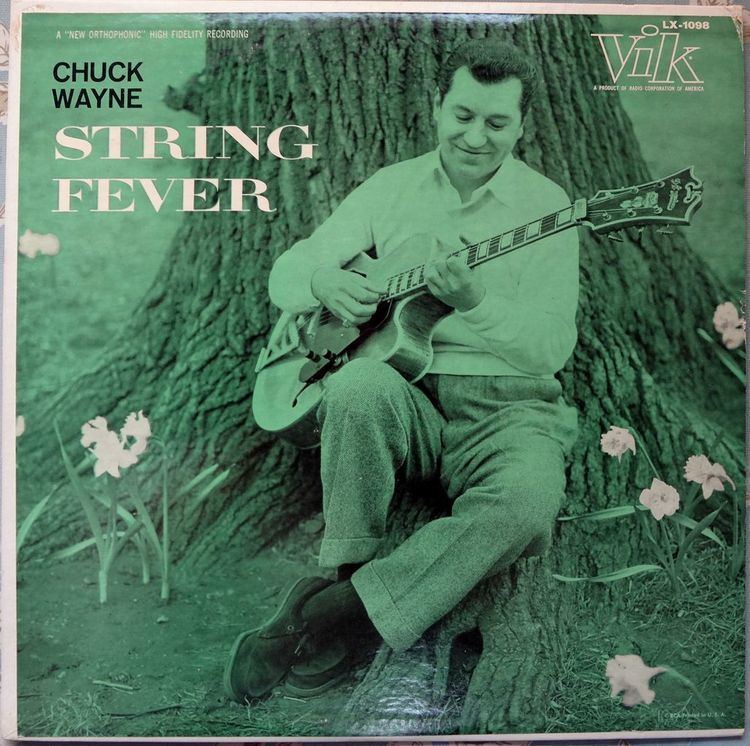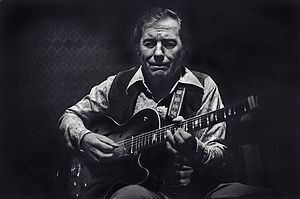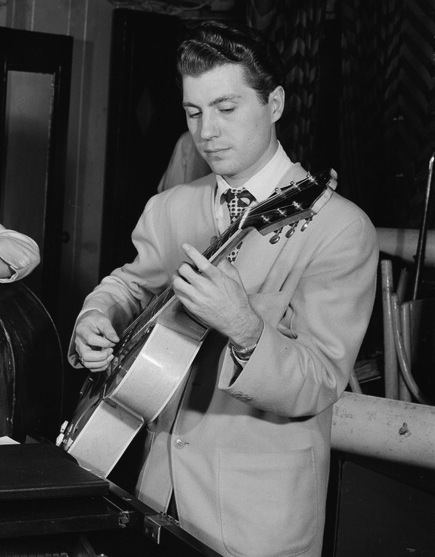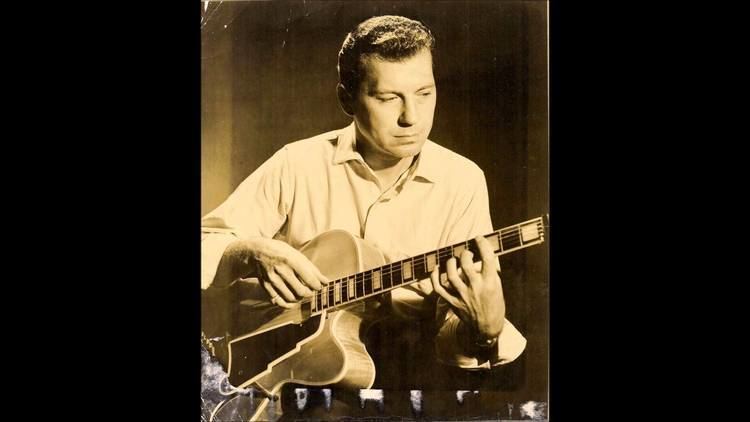Birth name Charles Jagelka Name Chuck Wayne | Years active 1940s — 1990s Instruments guitar | |
 | ||
Died July 29, 1997, Jackson Township, New Jersey, United States Albums The Jazz Guitarist, String Fever, Morning Mist Genres Jazz, Bebop, Swing music, Cool jazz Similar People | ||
The genius of chuck wayne
Chuck Wayne (February 27, 1923 – July 29, 1997) was a jazz guitarist who came to prominence in the 1940s. He is best known for his work with Woody Herman' and for being the first guitarist in the George Shearing quintet. He was also Tony Bennett's music director and accompanist from 1954–1957.
Contents
- The genius of chuck wayne
- Li l darlin by chuck wayne
- Style
- Life and work
- Compositions
- Recordings
- Discography
- Theory and technique
- Consecutive alternate picking
- Chords
- Concepts
- Open voicing and derivatives
- Use of Waynes chords
- Scales
- Arpeggios
- Octaves
- Putting it all together
- References

Li l darlin by chuck wayne
Style

Wayne was noted for a bebop style influenced by saxophone players of his time, especially Charlie Parker and Coleman Hawkins. In an era when many guitarists used four-square, mandolin-style picking, with rigid up-down stroke articulation, Wayne developed a technique not widely adopted by others until decades later. He also developed a comprehensive approach to guitar chords and arpeggios – based on generic tetrad forms spanning all possible inversions, in varying degrees of open voicing. This highly analytic approach to the fretboard was later documented in a series of theory books, some released posthumously.
Life and work

Wayne was born Charles Jagelka in New York City on 27 February 1923 to a Czechoslovakian family. In his youth, he became an expert on the banjo, mandolin, and balalaika. In the early 1940s he began playing jazz on 52nd Street and in Greenwich Village. After two years in the Army, he joined Joe Marsala's band at The Hickory House in 1944. Wayne was galvanized after hearing Charlie Parker at the Three Deuces and focused on playing bebop. At one point, frustrated with the difficulty of getting the sound he wanted, he considered switching to saxophone. Bill Crow writes:

He was one of the earliest guitarists to learn the bebop style. Chuck recorded with Dizzy Gillespie in 1945, on two sides that helped spread the bebop revolution, "Groovin' High" and "Blue 'n' Boogie."

Wayne replaced guitarist Billy Bauer in the Herman First Herd in 1946. He quickly won a more visible role for the guitar in the band, and was featured in exchanges with Stan Getz and Sonny Berman. He worked with Sarah Vaughan, Frank Sinatra, Barbra Streisand, Billy Taylor, Brew Moore, Claude Thornhill, Coleman Hawkins, Dizzy Gillespie, George Duvivier, Jack Teagarden, Jo Jones, Joe Marsala, Lester Young, Red Norvo, Slam Stewart, Tadd Dameron, Wingy Manone, Zoot Sims. In his later career, he was noted for duo performances in New York City with Warren Chiasson, Joe Puma, and Tal Farlow.
His style made increasing use of contrapuntal improvisation.
Wayne was best known for live performances, playing regular gigs in Manhattan, including a long stay at Gregory's on the upper East Side. Little of this music was recorded.
Wayne also played classical guitar, appeared on numerous television programs, worked with many Broadway shows, and wrote film scores.
During the 1990s, he continued to play in the New York area, though he was increasingly troubled by health problems. He died on 29 July 1997.
Compositions
Wayne was a respected composer. It is now well known that his tune "Sonny" (not SUnny), named for Sonny Berman, was appropriated by Miles Davis – who recorded and took composer credit for it as "Solar".
Various other Wayne tunes found their way into the bebop canon, such as "Butterfingers" and "Prospecting" (both of which had been attributed to Zoot Sims).
He also took on larger composition and arrangement projects for the theater and cinema.
Recordings
Wayne's 1946 debut solo album The Jazz Guitarist Chuck Wayne featured Zoot Sims and Brew Moore. It also included sidemen George Duvivier and Ed Shaughnessy. The album attracted critical attention; it was re-released as Tasty Pudding in 1954.
Wayne recorded several more albums, including Tapestry, String Fever (1957), Morning Mist (1964), Interactions (with Joe Puma, Point/Counterpoint (under Warren Chiasson's name), and Alberta Clipper (with Tom Butts).
Wayne made a famously unpopular album of banjo jazz in 1963. He loved the crisp, hornlike solo quality possible with the banjo, and was quoted as predicting a "banjo boom in the offing". He also plays banjo on "Lovely", the final track on Morning Mist.
Discography
With Duke Jordan
Theory and technique
Chuck Wayne invented a system of playing jazz guitar that emulated the style of Charlie Parker. His system included: consecutive-alternate picking, chords, scales, and arpeggios. The following summary reflects material in Wayne's method books.
Consecutive-alternate picking
The heart of the Chuck Wayne style for playing jazz guitar requires most of the movement of the pick to come from the joints of the first finger and thumb and not from the wrist, hand, or arm. The pick is not held rigidly; its angle changes slightly as it passes over the string. The tip of the pick drags slightly during each stroke, so that the tip points up during a downstroke, and down during an upstroke. (The effect is reminiscent of the appoyando or "rest stroke" used by classical guitarists – particularly if the movement is exaggerated with slow deliberate strokes, allowing the pick to stop on the adjacent string.)
In addition, when moving between adjacent strings, Wayne's system has the guitarist continue a single up or down stroke to play consecutive notes on two strings. Thus, when moving to a higher string (higher in pitch), the downstroke continues over two strings; when moving to a lower string, the upstroke continues. When more than two notes are played on a single string, the guitarist alternates strokes (or uses a slur, depending on the phrasing). This technique eliminates the "plinka-plinka" effect of traditional alternate picking, and allows smooth, rapid playing.
In rapid passages, the right hand is typically anchored, lightly, by touching the pinky fingernail to the pick guard – which itself should be placed close to and slightly below the first string. A narrow pick guard for this use, usually of ebony, became known among luthiers as a "Chuck Wayne style pick-guard" or more accurately as a "finger rest."
Some guitarists have referred to consecutive/alternative picking as "spray picking", although Wayne disliked this term.
Wayne was also an exponent of the use of the right-hand fingers, in combination with the pick. This technique has regained much popularity today, but for decades only Wayne and a few other jazz players used it effectively. Wayne's approach synthesized plectrum and classical guitar technique – the pick is held in the normal way, but the remaining three fingers are used to play chords and counterpoint. Wayne often surprised audiences by using this method to play difficult Bach fugues and other pieces from the classical repertoire. His use of the technique for contrapuntal improvisation was the real innovation, however.
Chords
Wayne's chord system is based on generic chord forms, i.e. forms that have the same sonority in all keys, and that do not rely on open strings or guitaristic peculiarities.
Wayne observed that most guitar chords in common use do not have these properties – that the way most guitarists play a G7 chord, for example, sounds very different from the way they play a C7 or an E7, due to the different arrangements of notes being used. The common ("cowboy") chords are popular because they simplify fingering; but they constrict musical options. Wayne constructed an entirely new approach that would avoid this problem. (Wayne did also use specific chord forms, when appropriate for a given situation; but his system focuses on chords with universal applications.)
To grasp the importance of Wayne's chord system, it is important to recognize that it truly is a system – a systematic approach to playing every named chord. His goal stands in marked contrast to the traditional way of describing and teaching guitar chords. Pick up nearly any chord book, and you will find a series of chord diagrams, organized either by chord name (A13, Gm7b5) or by type (thirteenth, minor seven-flat-five). Under each heading is found a series of fingerings that show the chord in alternative inversions and voicings – generally having little in common other than a shared set of notes. The guitarist simply memorises the forms, learning a few different ways to play each chord. Over time, through practical experience, the guitarist learns or decides when to use each form. When playing in Bb, such a guitarist will inevitably play with a very different set of voicings from what would be used in F or Eb, simply because the "normal" guitar chords in these keys have very different sonorities.
Wayne saw the pitfalls of this approach; he instead set out to describe the complete scope of harmonic possibilities available on the fretboard, in all voicings, given conventional guitar tuning and a human left hand. This had not been done before. It is still a remarkable achievement. Even today, few guitarists learn harmony or the fretboard this way – partly because Wayne's work remains somewhat obscure, but also because it requires levels of harmonic theory, practice discipline, and musical maturity that are rare in a novice young guitarist. (Instead, accomplished guitarists may come to this understanding of the fretboard "from the other side" – after mastering scales, harmony, and arpeggios, from which Wayne's system of chords will gradually reveal itself.)
Concepts
A generic chord (in Wayne's system) has four different notes. This includes chords like dominant sevenths, major sixths, and minor ninths – but not major or minor triads, or other specific triadic forms, which Wayne concluded were rarely useful for jazz. For chords containing five or more notes, such as thirteenths and ninths, Wayne removed the root, and other notes if necessary, to preserve the generic four-note form.
Wayne's focus on four-note generic chords reflects the realities of left hand fingering on a six-string guitar. Four-note chords can be comfortably played in many different voicings and fingerings; but five- or six-note chords only work in specific situations, and defeat the purpose of a generic approach. In effect, Wayne was trying to give the guitarist the harmonic vocabulary and flexibility available to pianists.
Since there are four different notes in each of Wayne's chords, there are four possible starting notes or inversions. (When such a chord contains the root, it is an inversion in the traditional sense; otherwise, it is a revoicing. For convenience, Wayne calls all such transformations "inversions".) The remaining notes are then arranged above it.
Open voicing and derivatives
Wayne realized that the close voicing normally used on pianos – i.e. where an entire chord is played within the same octave – is not usually practical on the guitar. He found that the most useful generic fingerings could be obtained by raising or lowering one or more of the four notes by an octave.
[The following descriptions cover the main elements of Wayne's chord system; but these may be hard to visualize. Wayne's method books, listed below, are the best source for diagrams and details.]
Use of Wayne's chords
Jazz musicians are very much attuned to how "open" a chord sounds; generally, the more open the voicing, the less chance of conflict between the chord and melody or improvisation. For this reason, while comping, Wayne especially used the spread and split voicings, which have the most "open" sound in his system. The other forms, being more "closed", are often chosen in arrangements using counterpoint and melody. However, there are no hard-and-fast rules for choosing a particular form in a given situation.
Surprisingly, Wayne's approach reveals many chord forms that are comfortable to play but rarely seen, except in classical guitar fingerings. This is particularly true of inversions that begin on the third or sixth/seventh, and also of certain split and spread voicings. In Wayne's heyday, experienced guitarists were often puzzled to watch him playing chord shapes that they didn't even recognize, chords with subtle differences from the norm. Wayne's novel strategy gave him an exceptionally wide harmonic palette, helping him avoid the sameness often found in the playing of guitarists – even some great ones.
Scales
Wayne's scale fingerings were designed to maximize use of consecutive/alternate picking, and thus to provide a legato feel. His basic scale fingerings are simple, although he also created various extended forms. Like his analytic approach to chords, his scale fingerings provide a single structure that can be applied to a variety of scale forms.
The simple rule for transverse diatonic, melodic minor, and harmonic minor scales is: 2-3-3-3-2-2, where each number represents the number of notes to play on each string, from low E to high E strings. The simple rule for his extended fingering is: 3-3-3-3-3 (five strings). Wayne provides many other fingering patterns in his "Scales" method book. The idea behind all of the various fingerings is that the student will be able to quickly learn the fretboard. In this way the player can create melodic lines that sound the best. The fingering patterns are practice exercises.
However, by generally playing three notes per string, consecutive picking across adjacent strings occurs frequently throughout the scale when forming a melodic line.
Arpeggios
The arpeggios in Chuck Wayne's system were explained in his book with his student, Ralph Patt. His arpeggios are derived from the rule for each two-octave arpeggio: 2-1-2-1-2 (five strings) for playing the tetrad (4 notes) harmonic forms of Chuck Waynes' chordal voicings. Unlike other ad-hoc arpeggio fingerings, the two notes per string followed by one note per string rule provides the characteristic legato sound of Chuck Wayne. Combined with the consecutive-alternate picking, the arpeggios resemble harp-like flows. Present day jazz guitarists refer to the harp-like sound as "sweep" although Chuck Wayne disliked this term since it refers to a broom.
The word arpeggio is a derivative of the word harp. The genius of the rule 2-1-2-1-2 manifests the harp-like lines and also allows the player to discover and play any arpeggio without the burden of questioning the awkward fret board fingering possibilities. The fingering is known, so it is up to the player to deploy the correct fingering for each tetradic inversion of choice. Arpeggios are revealed in two octaves. The starting note of an ascending arpeggio is either a note on the 6th string or a note on the 5th string, each voicing spanning five strings. The arpeggiated voicing is equivalent to the closed voicing on the piano.
There is a close relationship between Wayne's chord system and his arpeggio forms. A major milestone for Wayne's students was to experience a mental synthesis of his chord system and the arpeggio structures – revealing the internal relationships that link families of chords. Reaching this plateau would "unlock the fretboard", transforming it into something that could be approached more like a piano keyboard. This happens because Wayne's tetrad chord shapes are contained within the 2-1-2-1-2 fingerings.
Again the goal is to play melodic lines that sound the best on the instrument. Wayne taught many other arpeggio fingerings beginning with close chord form: 1-1-1-1 for one octave. Others for one octave are: 1-1-2, 1-2-1, 2-1-1, and 2-2. The 2-1-2-1-2 pattern above is derived from combining the 2-1-1 fingering for one octave and the 1-1-2 fingering for one octave.
Octaves
Another dimension of Chuck Wayne's style was his method of playing octaves. Since Chuck Wayne was an advanced classic guitarist as well as a plectrum player, he combined the two forms to play octaves. His right hand held the pick between the first finger and thumb to play the low note of the octave. His middle finger and ring finger alternated to play the upper note of the octave. His left hand used the "skip one" string form, which is using the index finger for the low note and the fourth finger for the upper note. In order to keep the left hand in position, the fourth finger is used to play the lower note and the first finger is used to play the upper note using the "skip two" (strings) form.
Putting it all together
The figure below depicts the major 7th tetrads (and the minor 9th equivalent) for the spread voicings as well as the arpeggios and the basic scales that correspond to one another in Chuck Wayne's "complete system" of jazz guitar. The vertical bar on the left of the chart(s) marks the tonic on the low E. Notice that the minor 9 framework does not have a tonic (root), since the first note is the 9th.
